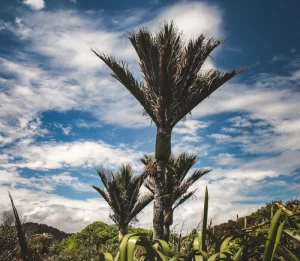Hey there! Today, we’re looking at a crucial aspect of prepping: identifying and foraging for edible wild plants in New Zealand. As someone who’s passionate about preparedness and the great outdoors, I’ve come to realize that knowing what’s safe to eat in the wild can be a game-changer in a survival situation. Here are some examples of edible plants you can find in New Zealand.
Wild Kawa Kawa (Macropiper excelsum)

Kawa Kawa, often called the “bushman’s friend,” is a versatile plant found throughout New Zealand. Its heart-shaped leaves are easy to spot. You can use them to brew a soothing tea that’s not only tasty but also packed with medicinal benefits. Plus, they’re abundant and make a fantastic addition to your survival menu.
NZ Spinach (Tetragonia tetragonioides)
NZ Spinach, also known as warrigal greens, is a hardy, drought-resistant green that can be found in coastal areas. It’s rich in vitamins and minerals, making it a valuable addition to your diet. Just make sure to blanch it before eating to remove any oxalates.
Watercress (Nasturtium officinale)
This peppery, aquatic plant is a powerhouse of nutrients. You can find watercress near freshwater streams and rivers. It’s not only delicious but also incredibly nutritious, packed with vitamins and minerals essential for your survival.
Harakeke (Phormium tenax)
Harakeke, or New Zealand flax, is well-known for its strong fibers, but it’s also edible. The nectar and seeds of the plant are a great addition to your meals.
PikoPiko (Hymenophyllum spp.)
Fern fronds are a Kiwi favorite. These fiddlehead ferns, also known as PikoPiko, are a Maori delicacy. They should be enjoyed cooked, and their unique flavor adds variety to your wild foraging diet.
Supplejack (Ripogonum scandens)
Supplejack is a climbing vine found in New Zealand’s forests. Its young shoots are edible and have a slightly nutty taste. They’re a great source of sustenance when you’re out in the wilderness.
Poroporo (Solanum laciniatum)
This native shrub produces small, tomato-like fruits when ripe. While it’s essential to know how to prepare them properly (they must be fully ripe and cooked) otherwise they are poisonous, they can be a valuable addition to your wild pantry.
Horopito (Pseudowintera colorata)
Horopito, also known as the New Zealand pepper tree, is a unique plant with spicy, peppery leaves. These leaves can be used to add flavor to your dishes, similar to black pepper. They are especially great for seasoning meats and adding a zesty kick to your wilderness meals. Horopito is a fantastic find for those looking to spice up their foraged cuisine in New Zealand.
Native Fuchsia (Fuchsia excorticata)
The berries of the native fuchsia plant are not only edible but also a favorite among birds and insects. When you find them, make sure to grab a few for yourself, as they’re both tasty and nutritious.
Nikau Palm Hearts (Rhopalostylis sapida)

The Nikau palm, known for its distinct appearance, also has an edible part – the inner base of its young leaves, known as “heart of palm.” These palm hearts are tender and have a mild, slightly nutty flavor. They can be eaten raw or cooked and are a valuable source of sustenance, especially if you’re in a coastal or forested area of New Zealand where Nikau palms grow. Keep in mind that the removal of the palm heart will kill the plant, therefore it should be only be considered in an emergency situation.
Remember, before snacking on any wild plant, it’s important to positively identify it and understand its preparation requirements. Some plants may have toxic look-alikes, so do your research and, if possible, learn from an experienced forager or expert. I’d also recommend getting the book, a field guide to native and edible plants of New Zealand by Andrew Crowe.
Incorporating edible wild plants into your prepping strategy not only diversifies your food sources but also connects you to the land and nature.
